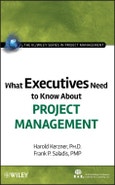As project management has evolved and matured, so has the executive's role in project management. To ensure the success of individual projects and the organization as a whole, today's executives are increasingly involved in activities such as capacity planning, portfolio management, prioritization, and strategic planning specifically for project management. In fact, more and more executives are becoming certified Project Management Professionals (PMPs).
What Executives Need to Know About Project Management offers executives a guide to project management, focusing on what they need to know and what they need to do. It provides step-by-step guidance to help executives get effective, well-resourced project management teams in place and ensure the success of any individual project.
The book begins with basic principles, including a detailed discussion of the three best practices that enable executives to ensure effective project management:
- Developing an environment where project management is viewed as a profession
- Securing key personnel for project management positions
- Creating opportunities for rewards and advancement through successful project management
Next, the book explores how executives serve as executive sponsors in project management teams, setting forth solutions to the many problems and challenges they face in this role, including managing disagreements, delegating authority, and accelerating projects.
The authors explain how the role of the executive sponsor changes depending upon the life-cycle phase of the project. For example, during the project initiation and planning phases, the sponsor may take on a very active role, ensuring that proper objectives are established and that the project plan satisfies the needs of the business as well as the needs of the client. During the execution phase, the sponsor may take on a less active role; however, the book shows how executive sponsors need to become involved when roadblocks appear, crises occur, and conflicts arise over priorities among projects.
Throughout the book, helpful illustrations clarify complex concepts and processes.
Table of Contents
Preface ix
Acknowledgments xiii
International Institute for Learning, Inc. (IIL) xv
Chapter 1: PROJECT MANAGEMENT PRINCIPLES 1
The Triple Constraint 2
Types of Project Resources 4
Chapter 2: THE EVOLUTION OF PROJECT MANAGEMENT 7
Evolution 8
Project Objectives 10
Definition of Success 12
Velocity of Change 14
Authority and Job Descriptions 16
Evaluation of Team Members 18
Accountability 20
Project Management Skills 22
Management Style 24
Project Sponsorship 26
Project Failures 28
Improvement Opportunities 30
Resistance to Change 32
Chapter 3: THE BENEFITS OF PROJECT MANAGEMENT 35
Benefits 36
Quantifying the Benefits 60
Chapter 4: THREE CORE BEST PRACTICES 63
The First Best Practice 64
The Second Best Practice 66
The Third Best Practice 68
Chapter 5: ROLE OF THE EXECUTIVE AS A PROJECT SPONSOR 71
How Executives Interface Projects 72
The Executive Sponsor’s Role 74
Chapter 6: SPECIAL PROBLEMS FACING EXECUTIVES 185
Pushing Sponsorship Down 186
Committee Sponsorship 190
Handling Disagreements with the Sponsor 192
Knowing When to Seek Out the Project Sponsor for Help 194
Types of Sponsor Involvement 196
Placating the (External) Customers 198
Gate Review Meetings 200
Sponsorship Problems 202
The Exit Champion 204
Should a Sponsor Have a Vested Interest? 206
Project Champions versus Exit Champions 208
The Collective Belief 210
Advertising Sponsorship 212
Working with the On-Site Representatives 214
Kickoff Meetings for Projects 216
Taking the Lead 218
Rewarding Project Teams 220
Enterprise Project Management 222
Executive Involvement (with Trade-offs) 224
Chapter 7: NEW CHALLENGES FACING SENIOR MANAGEMENT 227
Measuring Project Management Success after Implementation 228
Success 230
Types of Values 232
Four Cornerstones of Success 234
Success versus Failure 236
High-Level Progress Reporting 238
Validating the Assumptions 240
Accelerating Projects 242
Project Manager Selection 244
Delegation of Authority 246
Visible Support 248
Channels of Communication 250
Avoid Buy-ins 252
Budgeting 254
Working Relationships 256
Chapter 8: ADDITIONAL RESPONSIBILITIES FOR EXECUTIVES 259
The New Role for Executives 260
Activities for a Project Management Office 268
The Executive Interface 270
Expectations 272
A Structured Path to Maturity 276
An Unstructured Path to Maturity 278
Conclusions 280
Index 283








